International Journal of Clinical Cardiology
Beverage Specific Effect of Alcohol on Ishaemic Heart Disease Mortality in Russia
YE Razvodovsky*
Grodno State Medical University, Belarus
*Corresponding author: YE Razvodovsky, Grodno State Medical University, 80 Gorky Street, Grodno 230009, Belarus, Tel: + 375 0152 70 18 84; Fax: +375 0152 43 53 41; E-mail: razvodovsky@tut.by
Int J Clin Cardiol, IJCC-1-013, (Volume 1, Issue 2), Research Article; ISSN: 2378-2951
Received: September 09, 2014 | Accepted: November 22, 2014 | Published: November 26, 2014
Citation: Razvodovsky YE (2014) Beverage Specific Effect of Alcohol on Ishaemic Heart Disease Mortality in Russia.Int J Clin Cardiol 1:013. 10.23937/2378-2951/1410013
Copyright: © 2014 Razvodovsky YE. This is an open-access article distributed under the terms of the Creative Commons Attribution License, which permits unrestricted use, distribution, and reproduction in any medium, provided the original author and source are credited.
Abstract
Objective: It was repeatedly emphasized that alcohol provides the most plausible explanation for both the high rate and the dramatic fluctuation in Russian ischemic heart disease (IHD) mortality rate during the last decades, while other traditional risk factors identified in epidemiologic studies had little predictive value. The link between IHD mortality and beverage-specific alcohol drinking has been analyzed in a number of aggregate-level studies with conflicting results. The aim of this study was to examine the relation between the consumption of different beverage types and IHD mortality rates in Russia.
Method: Time-series analytical modeling techniques (ARIMA) were used to examine the relation between the sale of different alcoholic beverages and age-standardized male and female IHD mortality rates.
Results: Vodka consumption as measured by sale was significantly associated with both male and female IHD mortality rate. The consumption of beer and wine were not associated with IHD mortality rate. The estimates of the age specific models for men were positive and ranging from 0.033 (75+ age group) to 0.118 (15-29 age group). The estimates for women were positive for the 30-44 age group (0.132), 45-59 age group (0.82) and 60-74 age group (0.42).
Conclusions: The findings from this study suggest that IHD mortality tend to be more responsive to changes in spirits consumption per capita than to the wine/beer consumption..
Keywords
Ischemic heart disease, Beverage-specific alcohol sale, ARIMA time series analysis, Russia, 1980-2005.
Introduction
There is convincing evidence that light to moderate alcohol consumption protects against the risk of ischemic heart disease (IHD), while heavy episodic or binge drinking is associated with an increased risk of cardiovascular events [1-4]. Studies that have looked at pattern of drinking have consistently found that binge drinking an increased risk of IHD death [1,5,6]. A recent meta-analysis of 14 studies containing 4,718 IHD events suggests that heavy irregular drinking occasions (60 g. of pure alcohol per occasion) is significantly associated with incidence of IHD morbidity and mortality compared with regular moderate drinking (RR=1,45;CI:1,24-1,7) [7]. This meta-analysis offer evidence that drinking pattern modifies the effects of alcohol intake on the IHD risk. That means that the cardioprotective effect of moderate alcohol consumption disappears when light to moderate drinking is mixed with irregular heavy drinking occasions. Researchers have shown that binge drinking produce adverse cardiovascular effects including an atherogenic profile, increased risk of thrombosis and probability of arrhythmia [8,9].
The link between IHD mortality and population drinking has been analyzed in a number of aggregate-level studies with conflicting results. Hemstrom conducted time-series analyses of per capita consumption and IHD mortality in Western European countries with control for smoking [10]. The results suggested an unsystematic distribution of non-significant alcohol effect estimates. In a more recent study using a pooled cross-sectional analysis [11] showed that in countries with favorable drinking pattern, per capita consumption was negatively associated with IHD mortality whereas a positive link was found in countries with the binge drinking pattern.
Important aspect of drinking such as beverage preference is associated with drinking pattern and represents potential confounder of alcohol-IHD inter-relationship. In a review of population level studies it was concluded that there exists a strong inverse association between consumption of wine and mortality from IHD, while the association was weaker or non-existent for spirits and beer [12]. It was shown; however, that consumption of spirits per capita is positive related to heart disease mortality in six of the nine Western countries [9]. Similarly, it was highlighted that in Belarus relationship between alcohol and IHD mortality was stronger for consumption of spirits (vodka) relative to overall alcohol as well as wine/beer consumption [13].
It was repeatedly emphasized that alcohol provides the most plausible explanation for both the high rate and the dramatic fluctuation in Russian IHD mortality rate during the last decades, while other traditional risk factors identified in epidemiologic studies had little predictive value [14-19]. The existing research evidence supports a positive aggregate-level association between overall alcohol consumption and IHD mortality rate in Russia. In particular, the results from recent time series analysis based on Russian data from 1959 to 1998 highlights that alcohol consumption has a positive and statistically significant association with both overall and premature male IHD mortality; a 1 litre change in per capita consumption was associated with a 3.6% increase in overall male IHD mortality and a 4.5% increase in the age group of 30-54 years [20].
The distinctive trait of Russian drinking culture is the preference for binge drinking of vodka, leading to an increase in deaths from alcohol poisoning and cardiovascular diseases [21-25]. Evidence of a major effect of binge drinking on Russian cardiovascular mortality pattern comes from both aggregate level analyses and studies of individuals [8,19,26,27]. The results from recent study based on Russian data for the period from 1956 to 2005 suggest a positive association between fatal alcohol poisoning (as a proxy for binge drinking) and cardiovascular mortality rate [28]. Similarly, close aggregate level association between fatal alcohol poisoning and IHD mortality rate in Russia has been reported for the period between 1956 and 1998 [20]. The results from recent time series analysis based on data from 1970 to 2005 highlight that the relationship between alcohol and IHD was stronger in case of vodka sale compared to overall alcohol as well as wine/beer sale: 1 litre changes in per capita vodka sale was associated with increase in IHD rates by 9.3% for men and by 6% for women [28]. This piece of evidence provides additional support for the hypothesis that unfavorable mixture of binge drinking of vodka may be a major reason for the strong association between alcohol consumption and IHD rate in Russia.
In this study we will further test the hypothesis of beverage specific effect on IHD in Russia by analyzing time series data on sex and age-specific suicide rate between 1980 and 2005.
Material and methods
Data: The data on age-adjusted sex-specific IHD mortality rates per 1000,000 of the population are taken from the Russian State Statistical Committee (Rosstat). The Rosstat's cause of death classification has undergone several changes in recent decades. Until 1988 the cause of death classification was based upon the Soviet nomenclature which had a limited number of causes of death in comparison with the International Classification of Diseases (ICD) system. From 1989-1998 Rosstat used a coding scheme that was based on ICD-9. From 1999 a new coding system based on ICD-10 was introduced. Rosstat issued a table of correspondence between its classification system and ICD-9 and ICD-10 and it has been claimed that the Russian system of coding was and is compatible with the ICD. For example Soviet classification 90-95 «Ischemic heart disease " corresponds with ICD-9 code E 410-E 414 and with ICD-10 code I20-I25. The data on per capita beverage specific alcohol sales were taken from Rosstat's annual reports.
Statistical analysis: To examine the relation between changes in the consumption of different types of alcoholic beverage and IHD mortality across the study period a time-series analysis was performed using the statistical package "Statistica". The dependent variables were the annual IHD mortality and the independent variables were aggregate overall alcohol and beverage-specific sales. It is frequently the case that changes in per capita sales of one beverage will be correlated with overall alcohol sales per capita. Therefore in order to separate the specific effect of vodka sales per capita from overall alcohol sales we tested vodka sale in term of its ratio to total alcohol sales. Bivariate correlations between the raw data from two time-series can often be spurious due to common sources in the trends and due to autocorrelation [29]. One way to reduce the risk of obtaining a spurious relation between two variables that have common trends is to remove these trends by means of a 'differencing' procedure, as expressed in formula:
This means that the annual changes '∇' in variable 'X' are analyzed rather than raw data. The process whereby systematic variation within a time series is eliminated before the examination of potential causal relationships is referred to as 'prewhitening'. This is subsequently followed an inspection of the cross-correlation function in order to estimate the association between the two prewhitened time series. It was Box and Jenkins [30] who first proposed this particular method for undertaking a time series analysis and it is commonly referred to as ARIMA (autoregressive integrated moving average) modeling. We used this model specification to estimate the relationship between the time series IHD mortality rate and beverage-specific alcohol sales in this paper. In line with previous aggregate studies [29,30], we estimated semi-logarithmic models with logged output. The following model was estimated:
where ∇ means that the series is differenced, M is IHD mortality rates, a indicates the possible trend in IHD mortality due to other factors than those included in the model, A is the alcohol sale, β is the estimated regression parameter, and N is the noise term. The percentage increase in IHD mortality rate rates associated with a 1-litre increase in alcohol sale is given by the expression: (exp(β1)-1)*100.
Results
Descriptive statistics are presented in Table 1. Across the whole period the male age-standardized IHD mortality rates was higher than the female rates. The trends in the age-adjusted, sex-specific IHD mortality rates are displayed in Figures 1-8. Sex-specific stroke mortality rate yield patterns that vary little from each other over time. For both sexes the time series of IHD mortality rates fluctuated greatly over the period: decreasing substantially between 1984 and 1988, than jumping dramatically during 1991 to 1994. From 1995-1998 there was a fall in the rates before they again began to rise while a decrease in rates has been recorded in the most recent years. It should be also emphasis that working-age males and females showed greater decrease in IHD mortality in the mid-1980s, while fluctuations in IHD mortality rates for oldest age groups of both men and women were more pronounced during the 1990s (Figures 1-8).
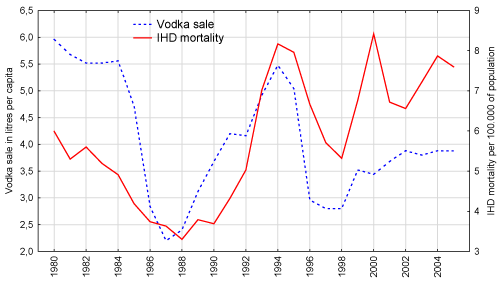
Figure 1: Trends in IHD mortality rate and vodka sales per capita in Russia
between 1980 and 2005 for men age group of 15-29 years.
View Figure 1
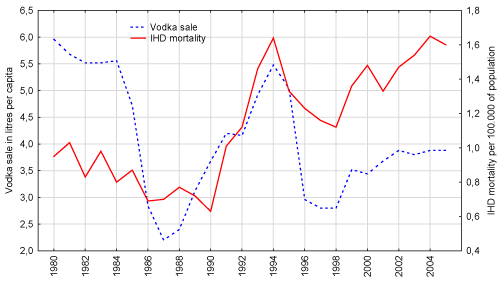
Figure 2: Trends in IHD mortality rate and vodka sales per capita in Russia
between 1980 and 2005 for women age group of 15-29 years.
View Figure 2
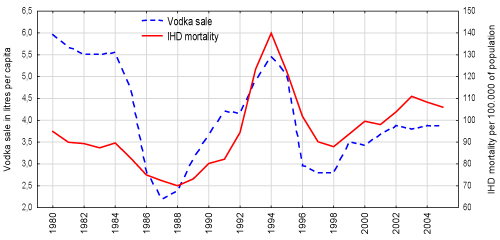
Figure 3: Trends in IHD mortality rate and vodka sales per capita in Russia
between 1980 and 2005 for men age group of 30-44 years.
View Figure 3
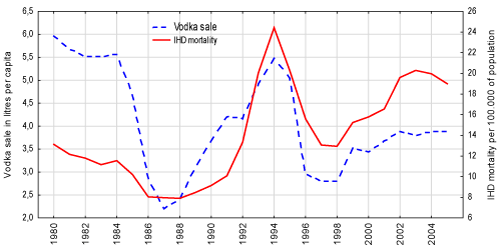
Figure 4: Trends in IHD mortality rate and vodka sales per capita in Russia
between 1980 and 2005 for women age group of 30-44 years.
View Figure 4
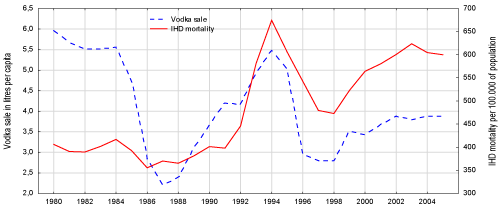
Figure 5: Trends in IHD mortality rate and vodka sales per capita in Russia
between 1980 and 2005 for men age group of 45-59 years.
View Figure 5

Figure 6: Trends in IHD mortality rate and vodka sales per capita in Russia
between 1980 and 2005 for women age group of 45-59 years.
View Figure 6
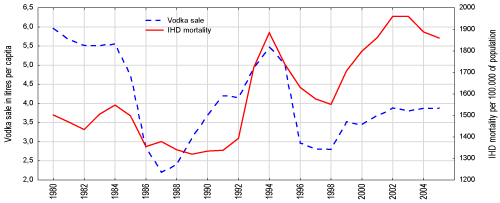
Figure 7: Trends in IHD mortality rate and vodka sales per capita in Russia
between 1980 and 2005 for women age group of 60-74 years.
View Figure 7
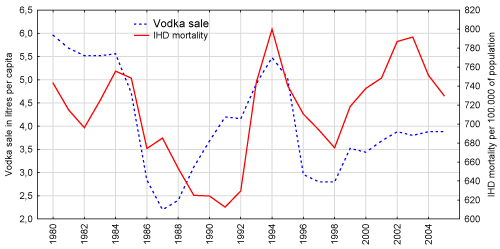
Figure 8: Trends in IHD mortality rate and vodka sales per capita in Russia
between 1980 and 2005 for women age group of 60-74 years.
View Figure 8
The average per capita alcohol sales figure was 7.66 liters with vodka being the drink overwhelmingly consumed (Table 1). However, these mean figures mask differing trends among the beverages across the period. While there has been a substantial drop in vodka sales from 5.96 liters in 1980 to 3.88 liters in 2005 and wine sales have remained at roughly the same level there has been a sharp growth in beer sales - especially in recent years. Between 1998 and 2005 the per capita sales figure for beer rose from 1.16 to 3.08 liters. It is also worth noting that beverage sales have experienced sharp fluctuations across the period. Thus, a brief Andropov's anti-alcohol campaign in the early 1980s resulted in a decline in vodka sales. An especially sharp fall was recorded in vodka and wine sales in 1985-1987 that coincided with Mikhail Gorbachev's anti-alcohol campaign. Similarly, the collapse of the Soviet Union and the ending of the state's alcohol monopoly in the early 1990s were accompanied by a sharp rise in vodka sales.
![]()
Table 1: Descriptive statistics, Russia 1980-2005.
View Table 1
The graphical evidence also suggests that the trends for IHD mortality and vodka sale are rather similar over the time series for both sexes in all age group, especially in the age groups 30-44 and 45-59 (Figures 3-6). As can be seen, there were sharp trends in the beverage-specific alcohol sale and IHD mortality time series across the study period. These trends were removed by means of a first-order differencing procedure. After prewhitening, the ARIMA modeling was used to estimate the relationship between the time series IHD mortality rate and beverage-specific alcohol sales. The analysis suggests that of the three beverages vodka alone was associated with IHD mortality in Russia. The consumption of beer and wine were not associated with IHD mortality rate. The specification of the bivariate ARIMA model and outcome of the analyses are presented in Table 2. The estimates of the age specific models for men were positive and ranging from 0.33 (75+ age group) to 0.118 (30-44 age group). These results suggest that 1 litre changes in per capita vodka sale was associated with increase in IHD rates by 3.3% for men age group 75+ and by 11.8% for men age group 30-44. The estimates for women were positive for the 30-44 age groups (0.132), 45-59 age group (0.82) and 60-74 age groups (0.42).
![]()
Table 2: Estimated effects of vodka sales on IHD mortality rates, ARIMA analysis.
View Table 2
Discussion
According to the results of time-series analysis there was a positive and statistically significant effect of per capita vodka sales on IHD mortality in Russia. These findings provide support for the binge drinking hypothesis, suggested that episodic heavy drinking of spirits is an important determinant of IHD mortality crisis in Russia. The size of the bivariate association between the level of vodka sale and IHD mortality rate varied widely between age groups, indicating the difference in alcohol consumption rate. As expected, middle age men and women had the strongest association between the level of vodka sale and IHD mortality rate. This reflects the fact that the level of alcohol-related problems among middle aged is especially high [32].
There is evidence that the IHD mortality trends in Russia influenced by the four major factors: the long-standing mortality crisis that began in the USSR in the 1960s, the brief Andropov's anti-alcohol campaign in the early 1980s, Gorbachev's anti-alcohol campaign 1985-88 and severe socioeconomic crisis imposed by rapid societal transformation in the early 1990s. A fairly close aggregate-level match between vodka sales and IHD mortality during the Andropov's and Gorbachev's anti-alcohol campaigns may be use as evidence for the hypothesis suggesting that alcohol is responsible for a substantial number of IHD deaths in Russia.
The strong aggregate level association between vodka sales and IHD mortality rate in Russia might be an outcome of a preference for spirits among heavy drinkers. In a prospective cohort study of 6502 men aged 25-64 years [33] showed that frequent heavy drinking, defined as drinking at least three times a week in a dose greater than 120 g of ethanol per occasion, is significantly associated with incidence of cardiovascular mortality compared with moderate drinking (RR=2,05: 1,69-3,86) [30].
On the other hand, several researchers argue that alcohol unlikely provide the universal explanation for the mortality fluctuations during 1980s in Russia as the proportion of heavy binge drinkers in women is negligible, but the temporal changes in deaths rates were similar in men and women [34]. They believe that the decrease in mortality rates in Russia in the mid-1980s could have been related to the political and social liberalization during the period known as "perestroika", which gave rise to social optimism and new hope. However, recent findings from neighboring Belarus based on autopsy reports from the Bureau of Forensic Medicine suggest that the number of BAC-positive cardiovascular deaths shrank by 33,6%, while the number of BAC-negative deaths increased by 14,4% during Gorbachev's perestroika [28].
The outcomes from Novosibirsk study have important implications for understanding the role of binge drinking in the Russian mortality crisis during 1990s [33]. It was highlighted that the rates of frequent heavy drinking increased from 3,5% in 1985/86-1988/89, to 8.4% in 1994/95; the corresponding attributable risk fraction for cardiovascular deaths would be 7% in the 1980s and 16% in the 1990s. These findings, as well as the results of present study, highlighting close aggregate level association between vodka sale and IHD mortality rates strongly support an alcohol related hypothesis and suggest that rather that playing major causal role, psychosocial distress may represent a confounding factor. It seems plausible that the psychosocial distress was the main cause of increased demand for alcohol at this time. This demand was met by factors that increased supply following the repeal of state alcohol monopoly in 1992.
There are several potential factors behind the decrease in vodka sale and IHD mortality rate between 1994 and 1998. They include better regulation of the alcohol market that may have resulted in a relative increase in prices for vodka compared to those for food products [21]. Another possible factor in the decrease in vodka sale was impoverishment and decrease in the purchasing capacity of the population due to unpaid or delayed salaries [24]. On the other hand, the decreases in IHD mortality in 1994-98 coincided with improvement in the economic situation, while the increases since 1998 correlate with financial crisis and worsening economic situation.
Before concluding, several potential limitations of this study must be mentioned. In particular, we relied on official alcohol sales data as a proxy measure for trends in alcohol consumption across the period. However, the unrecorded consumption of alcohol was commonplace in Russia throughout the study period, especially in the mid-1990s, when a considerable proportion of vodka came from illicit sources [28]. Further, there was also the risk of omitted variable bias in this work. It should be emphasized that vodka sale per capita before the start of anti-alcohol campaign exceeded the level recorded in the early 1990s, while CVD mortality rates in the early 1990s exceeded the level of early 1980s significantly. This means that some additional factors came into play in the yearly 1990s.
Some experts suggest that the Russian IHD mortality crisis in the 1990s is most likely to have been precipitated by the psychosocial distress imposed by rapid societal transformation [35,36]. The impact of acute socioeconomic transition has been exacerbated by a lack of social cohesion, erosion of social capital, loss of control over life and rising income inequality [37]. That might undermine the health of the population. Nevertheless, the experience of some transitional Central and Eastern European countries does not necessarily imply that the implementation of rapid economic reforms is accompanied by growing mortality. For example, a rapid decline in IHD mortality in Poland was reported between 1991 and 1994 [38]. In Hungury, increase in IHD mortality was observed between 1970 and the early 1990s of 35%, but thereafter, a decrease of 2% year was noted [39].
It can be also assumed that psychosocial distress and alcohol consumption effects on IHD mortality are spurious indicators of the impact of other powerful risk factors, i.e. smoking. Smoking is associated with higher risk of IHD mortality [40]. However, use of tobacco products was relatively stable during 1970s-1980s and has fallen substantially in Russia over the 1990s, suggesting that IHD mortality crisis is not a result of a long-term response to smoking trends [24]. Further, in a recent time series analysis it was highlighted that smoking as indicated from sales data did not have a significant impact on IHD in Russia [20].
In conclusion, the present study suggests that IHD mortality tend to be more responsive to changes in spirits consumption per capita than to the wine/beer consumption. Assuming that drinking vodka is usually associated with intoxication episodes, these findings provide additional evidence that substantial proportion of IHD deaths in Russia are due to acute effect of binge drinking. The findings from the present study have important implications as regards alcohol policy in Russia suggesting that any attempts to reduce overall consumption should also be linked with efforts through differential taxation to shift beverage preference away from spirits.
References
-
Bagnardi V, Zatonski W, Scotti L, La Vecchia C, Corrao G (2008) Does drinking pattern modify the effect of alcohol on the risk of coronary heart disease? Evidence from a meta-analysis. Journal Epidemiology Community Health 62: 615-619.
-
Marmot MG (2001) Commentary: reflections on alcohol and coronary heart disease. Int J Epidemiol 30: 729-734.
-
Lucas DL, Brown RA, Wassef M, Giles TD (2005) Alcohol and the cardiovascular system: research challenges and opportunities. J Am Coll Cardiol 45: 1916-1924.
-
Anderson, P (2005) Alcohol and coronary heart disease. Addiciones 7: 3-10.
-
Puddey IB, Rakic V, Dimmitt SB, Beilin LJ (1999) Influence of pattern of drinking on cardiovascular disease and cardiovascular risk factors--a review. Addiction 94: 649-663.
-
Mukamal KJ, Conigrave KM, Mittleman MA, Camargo CA Jr, Stampfer MJ, et al. (2003) Roles of drinking pattern and type of alcohol consumed in coronary heart disease in men. N Engl J Med 348: 109-118.
-
Roerecke M, Rehm J (2010) Irregular heavy drinking occasions and risk of ischemic heart disease: a systematic review and meta-analysis. Am J Epidemiol 171: 633-644.
-
McKee M, Britton A (1998) The positive relationship between alcohol and heart disease in eastern Europe: potential physiological mechanisms. J R Soc Med 91: 402-407.
-
Brenner, MH (1987) Economic change, alcohol consumption and heart disease mortality in nine industrialized countries. Soc Sci Med 25: 119-132.
-
Hemström O (2001) Per capita alcohol consumption and ischaemic heart disease mortality. Addiction 96 Suppl 1: S93-112.
-
Gmel, G, Rehm, J, Frick, U Trinkmuster (2003) Pro-Kopf-Konsum von Alkohol und koronare Mortalitat. Sucht 49: 95-104.
-
Rimm EB, Klatsky A, Grobbee D, Stampfer MJ (1996) Review of moderate alcohol consumption and reduced risk of coronary heart disease: is the effect due to beer, wine, or spirits. BMJ 312: 731-736.
-
Razvodovsky, YE (2001) Alcohol and cardiovascular mortality: epidemiological aspect. Alcologia 13: 107-113.
-
Chenet L, McKee M, Leon D, Shkolnikov V, Vassin S (1998) Alcohol and cardiovascular mortality in Moscow; new evidence of a causal association. J Epidemiol Community Health 52: 772-774.
-
McKee M, Shkolnikov V, Leon DA (2001) Alcohol is implicated in the fluctuations in cardiovascular disease in Russia since the 1980s. Ann Epidemiol 11: 1-6.
-
Averina M, Nilssen O, Brenn T, Brox J, Kalinin AG, et al. (2003) High cardiovascular mortality in Russia cannot be explained by the classical risk factors. The Arkhangelsk Study 2000. Eur J Epidemiol 18: 871-878.
-
Brainerd E, Cutler DM (2005) Autopsy on an Empire: Understanding mortality in Russia and the former Soviet Union. Journal of Economic Perspective 19: 107-130.
-
Leon DA, Chenet L, Shkolnikov VM, Zakharov S, Shapiro J, et al. (1997) Huge variation in Russian mortality rates 1984-94: artefact, alcohol, or what? Lancet 350: 383-388.
-
Nilssen O, Averina, M, Brenn, T, Drox, J, Kalinin, A, Archipovski, V (2005) Alcohol consumption and its relation to risk factors for cardiovascular disease in the north-west of Russia: the Archangelsk study. Int J Epidemiol 34: 781-788.
-
Ramstedt M (2009) Fluctuations in male ischaemic heart disease mortality in Russia 1959-1998: assessing the importance of alcohol. Drug Alcohol Rev 28: 390-395.
-
Nemtsov AV (2002) Alcohol-related human losses in Russia in the 1980s and 1990s. Addiction 97: 1413-1425.
-
Shkolnikov VM, McKee, M, Chervyakov, VV, Kyrianov, NA (2002) Is the link between alcohol and cardiovascular death among young Russian men attributable to misclassification of acute alcohol intoxication? Evidence from the city of Izhevsk. J Epidemiol Community Health 56: 171-175.
-
Room R (2005) Commentary: Pattern of drinking and the Russian heart. Int J Epidemiol 34: 788-790.
-
Nemtsov AV, Razvodovsky YE (2008) Alcohol situation in Russia, 1980-2005. Social and Clinical Psychiatry 2: 52-60.
-
Zaridze D, Maximovitch D, Lazarev A, Igitov V, Boroda A, et al. (2008) Alcohol poisoning is a main determinant of recent mortality trends in Russia: evidence from a detailed analysis of mortality statistics and autopsies. Int J Epidemiol 38: 143-153.
-
Britton A, McKee M (2000) The relation between alcohol and cardiovascular disease in Eastern Europe: explaining the paradox. J Epidemiol Community Health 54: 328-332.
-
Perova NV, Oganov RG, Williams DH, Irving SH, Abernathy JR, et al. (1995) Association of high density lipoprotein cholesterol with mortality and other risk factors for major chronic non-communicable diseases in samples of US and Russian men. Ann Epidemiol 5: 179-185.
-
Razvodovsky YE (2009) Aggregate level beverage specific effect of a sale on myocardial infarction mortality rate. Adicciones 21: 229-237.
-
Norström T, Skog OJ (2001) Alcohol and mortality: methodological and analytical issues in aggregate analyses. Addiction 96 Suppl 1: S5-17.
-
Box GEP, Jenkins GM (1976) Time Series Analysis: forecasting and control. London. Holden-Day Inc.
-
Razvodovsky YE (2009) Alcohol poisoning and cardiovascular mortality in Russia 1956-2005. Alcoholism 45: 27-42.
-
Cockerham WC, Hinote BP, Abbott P (2006) Psychological distress, gender, and health lifestyles in Belarus, Kazakhstan, Russia, and Ukraine. Soc Sci Med 63: 2381-2394.
-
Malyutina S, Bobak M, Kurilovitch S, Gafarov V, Simonova G, et al. (2002) Relation between heavy and binge drinking and all-cause and cardiovascular mortality in Novosibirsk, Russia: a prospective cohort study. Lancet 360: 1448-1454.
-
Wasserman D, Värnik A, Eklund G (1994) Male suicides and alcohol consumption in the former USSR. Acta Psychiatr Scand 89: 306-313.
-
Leon DA, Shkolnikov VM (1998) Social stress and the Russian mortality crisis. JAMA 279: 790-791.
-
Stuckler D, King L, McKee M (2009) Mass privatisation and the post-communist mortality crisis: a cross-national analysis. Lancet 373: 399-407.
-
Andreeva E, Ermakov D, Brenner H (2008) The socioeconomic aetyology of suicide mortality in Russia. International Journal of Environment and Sustainable Development 7: 21-48.
-
Zatonski WA, Willett W (2005) Changes in dietary fat and declining coronary heart disease in Poland: population based study. BMJ 331: 187-188.
-
Kopp M, Skrabski A, Szanto Z, Siegrist J (2006) Psychosocial determinants of premature cardiovascular mortality differences withing Hungary. J Epidemiol Community Health 60: 782-788.
-
Kuulasmaa K, Tunstall-Pedoe H, Dobson A, Fortmann S, Sans S, et al. (2000) Estimation of contribution of changes in classic risk factors to trends in coronary-event rates across the WHO MONICA Project populations. Lancet 355: 675-687.





